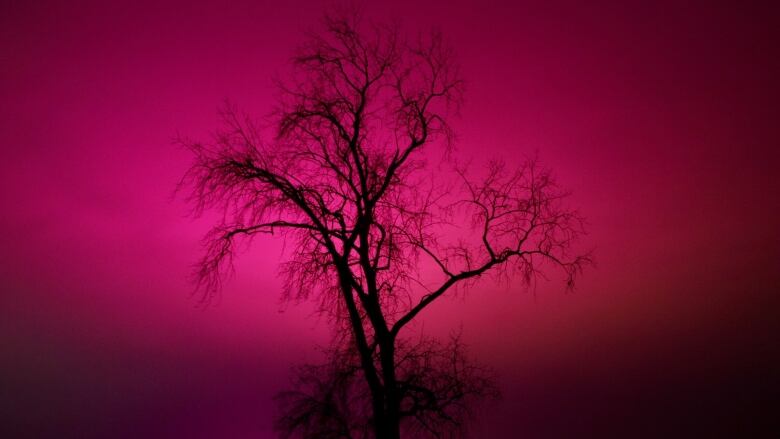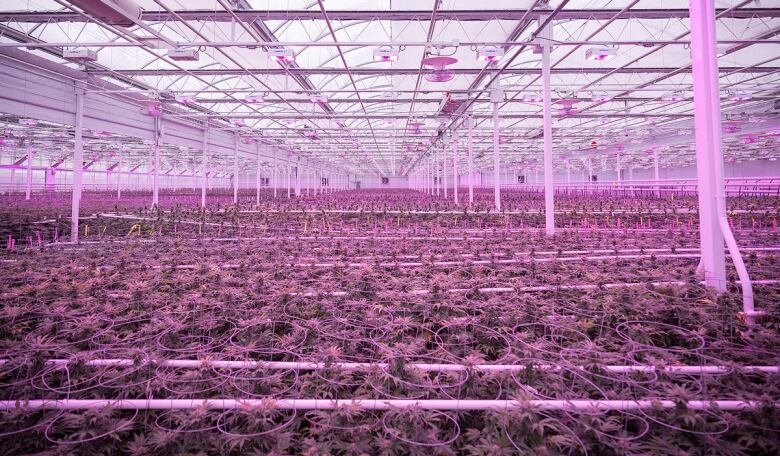Cannabis greenhouses are creating light pollution, but there are solutions
Lights block out stars on clear nights and create bright, colourful skies on overcast nights

The legalization of cannabis in Canada last October created a new type of agricultural industry. Some estimate cannabis could be worth $6.5 billion in retail sales alone. That's good news if you're a grower.
But, as with any new industry, there's a learning curve. And this one involves lights.
Growing cannabis is no easy task. The plants have different stages and require precise lighting cycles, with the largest area in greenhouses reserved for plants requiring 12 hours of sunlight and 12 hours of darkness. At one stage of growth, a plant might thrive best with18 hours of light.
If the sun doesn't provide adequate light, cultivators use artificial lights. These lights can be on at night, and the result particularly for large greenhouse facilities is a brightly litnight sky, commonly referred to as light pollution.

Light pollution plagues cities, but this time it's encroaching into rural areas, and some are concerned. For example, there have been complaints in Kingsville, Ont., Leamington, Pelham, and Langley, B.C.
The consequences of light pollution go beyond just not being able to see the stars. It can have serious ecological consequences, and studies suggest that it has adverse health effects on humans.
Consequences
Recent research suggests that light pollution can seriously affect birds, insects and even plants.
Some nocturnal animals may use the darkness to hunt, while nocturnal prey use the darkness to hide. Altering that can alter an entire ecosystem: prey suddenly become much more vulnerable and could even disappear.
Frogs, who use their croaking as part of their breeding ritual, have been shown to reduce their croaking in the presence of artificial light.
And artificial light also has been shown to disorient migratory birds.
As for humans, it throws off our circadian rhythm, our (roughly) 24-hour clock sleep/wake cycle. Some studies have shown that this disruption is linked to obesity, diabetes and heart disease. And there have also been some studies that suggest a moderate increase in the risk of breast canceramong nurses who are exposed to light at night due to shift work.
Lights of human activity shine in NASA's image of Earth at night
"It's become very clear to us that there are rhythms that are established by light and dark that are set to natural sources like the sun," said John Barentine, who lives in Arizona and is director of public policy at the International Dark-Sky Association. "And by exposing ourselves to artificial light during those times of day when the body and the brain don't expect them to be there, it can have the effect of beginning a cascade of biological processes that might lead to certain kinds of chronic diseases.
"We are animals that exist in a natural world and we're disrupting that natural world and that has distinct consequences."
'Good neighbours'
Barentine said that light pollution from greenhouses isn't anything new. What may be different here is that these greenhouses may be opening in rural locations where it's already dark.
"Depending on the scale of the operation, the light emission at night can be absolutely off the chart," he said.
But he acknowledges that cannabis stands to be an important revenue generator and source of employment in communities.

So how does a burgeoning industry cope with reducing light pollution and ensuring the health of wildlife and humans while at the same time ensuring they have healthy crops?
"I do feel for the position that this puts the operators in," Barentine said."My perception in talking to people here is that the operators are not very conscious of the light issue."
Last February, Canopy Growth faced backlash from residents in Langley, B.C., when theycomplained about the "disruptive" nighttime lights.
"There's always going to be a transition period," said Jordan Sinclair, vice-president of communications at Canopy Growth Corp., one of the largest cannabis growers in Canada. "The producers themselves have to go through a period of making sure they're good neighbours."
In response to the Langley complaints, Canopy added shades to the sides of the greenhouses which, Sinclair said, has reduced the light significantly without beingcost-prohibitive. Other growers can do the same, though it cantake weeks to months to install depending on the size of the operation.
While Barentine notes that there are no regulations for these greenhouses typically, lighting regulation pertains to outdoor lighting, not indoor it's something that municipalities are likely going to have to addressand soon.
"It's tricky," Barentine said. "We're beginning to get counties and municipalities, mostly here in the U.S., reaching out to us asking for help with the regulatory aspect. To be honest, this is so new in many respects, that we don't have an out-of-the-box policy solution to this."
Full disclosure: The author previouslyheaded the Toronto chapter of the International Dark-Sky Association.












_(720p).jpg)


 OFFICIAL HD MUSIC VIDEO.jpg)
.jpg)



























































































